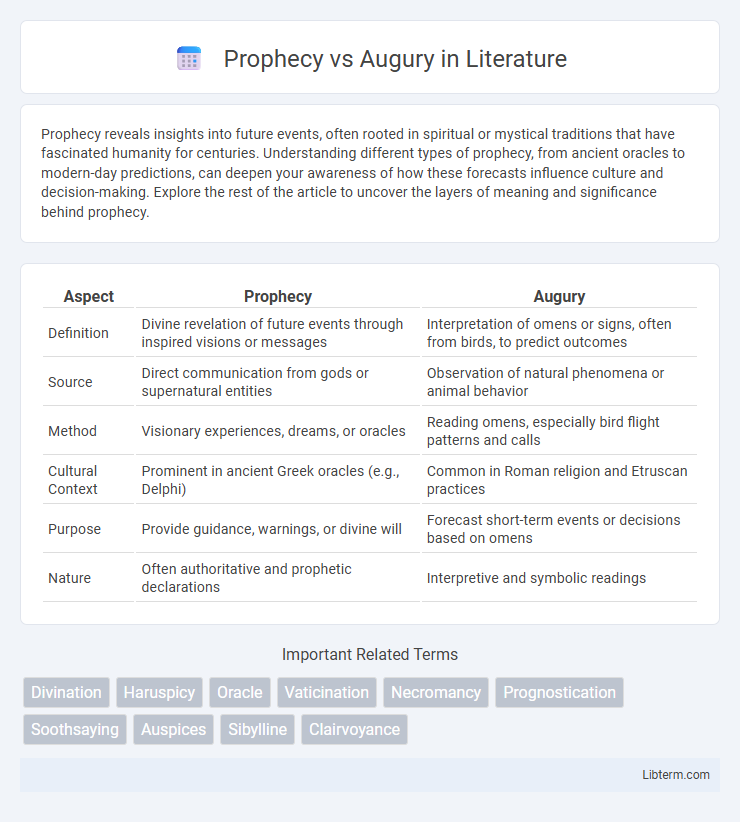Prophecy reveals insights into future events, often rooted in spiritual or mystical traditions that have fascinated humanity for centuries. Understanding different types of prophecy, from ancient oracles to modern-day predictions, can deepen your awareness of how these forecasts influence culture and decision-making. Explore the rest of the article to uncover the layers of meaning and significance behind prophecy.
Table of Comparison
| Aspect | Prophecy | Augury |
|---|---|---|
| Definition | Divine revelation of future events through inspired visions or messages | Interpretation of omens or signs, often from birds, to predict outcomes |
| Source | Direct communication from gods or supernatural entities | Observation of natural phenomena or animal behavior |
| Method | Visionary experiences, dreams, or oracles | Reading omens, especially bird flight patterns and calls |
| Cultural Context | Prominent in ancient Greek oracles (e.g., Delphi) | Common in Roman religion and Etruscan practices |
| Purpose | Provide guidance, warnings, or divine will | Forecast short-term events or decisions based on omens |
| Nature | Often authoritative and prophetic declarations | Interpretive and symbolic readings |
Understanding Prophecy and Augury
Prophecy involves receiving divine messages or insights about future events through direct communication with a deity or supernatural source, often delivered by prophets. Augury is the practice of interpreting signs, such as the behavior of birds or natural phenomena, to predict future outcomes, relying on ritualistic observation rather than direct revelation. Both methods serve as tools for forecasting, but prophecy emphasizes inspired foresight while augury depends on symbolic interpretation.
Historical Origins of Prophecy and Augury
Prophecy traces back to ancient Mesopotamian and Hebrew traditions where seers conveyed divine messages regarding future events, often through dreams or sacred rituals. Augury, originating in ancient Rome, involved interpreting the will of the gods by observing the flight patterns and behaviors of birds, serving as an official method to guide political and military decisions. Both practices served as critical tools in their societies for understanding and influencing fate based on supernatural insight.
Key Differences Between Prophecy and Augury
Prophecy involves receiving divine messages about the future through direct revelation, often conveyed by prophets who interpret these signs verbally or in writing. Augury relies on interpreting omens or natural phenomena, such as the flight patterns of birds or animal behavior, to predict future events. Key differences include prophecy being a direct communication from a deity, while augury is an interpretive practice based on observable signs in nature.
Methods Used in Prophecy and Augury
Prophecy primarily relies on divine revelation, dreams, visions, and inspired speech to communicate messages believed to come from gods or supernatural sources. Augury involves interpreting signs from natural phenomena such as the flight patterns of birds, animal entrails, or celestial events to predict future outcomes. Both methods serve as tools for decision-making and guidance but differ in their reliance on direct divine communication versus symbolic interpretation of omens.
Cultural Significance of Prophecy
Prophecy holds profound cultural significance as it has shaped religious beliefs, inspired literature, and influenced political decisions across civilizations. Serving as a means to communicate divine will, prophecies often guided moral conduct and societal norms in ancient cultures such as Mesopotamia, Greece, and Israel. Unlike augury, which primarily relies on interpreting omens from natural signs for immediate guidance, prophecy encompasses a broader spiritual and cultural role by revealing future events and divine intentions.
Religious Aspects of Augury
Augury, rooted in ancient Roman religion, served as a sacred practice where priests, known as augurs, interpreted the will of the gods through the observation of natural phenomena such as bird flight patterns and lightning. This religious ritual was integral to state decisions, its divine guidance believed essential for ensuring favor from the gods before important events like battles or political assemblies. Unlike broader prophecy, which could encompass spontaneous divine revelations or oral predictions, augury was a formalized and institutionalized method strictly tied to the religious hierarchy and ritual purity.
Famous Prophets and Augurs in History
Famous prophets such as Nostradamus and the biblical Isaiah have shaped history by delivering divinely inspired predictions that influenced decisions and cultures globally. In contrast, renowned augurs like the Roman augurs, including figures such as Augustus, utilized ritualistic bird flight interpretations and omens to guide political and military strategies in Ancient Rome. These distinct yet intertwined practices highlight the cultural importance of foreknowledge through prophecy's visionary revelations and augury's interpretive omen analysis.
Modern Perspectives on Prophecy and Augury
Modern perspectives on prophecy emphasize its ongoing role in personal and collective decision-making, often integrating psychological and spiritual insights to anticipate future trends. Augury, traditionally associated with interpreting signs and omens, has evolved into a symbolic practice used in contemporary contexts such as decision support and intuition development. Both prophecy and augury are increasingly studied for their cultural significance and their impact on human cognition and predictive behaviors.
Skepticism and Criticism of Divination Practices
Skepticism surrounding prophecy and augury centers on the lack of empirical evidence supporting their accuracy and the subjective interpretation of signs or visions, often leading to contradictory predictions. Critics argue that confirmation bias and the vague nature of prophetic messages undermine their reliability as tools for decision-making. Scientific inquiry consistently challenges the validity of divination practices, highlighting psychological factors such as the Barnum effect as explanations for perceived successful predictions.
The Future of Prophecy and Augury
The future of prophecy and augury lies in their evolving roles within modern spirituality and technology-enhanced divination practices. Emerging trends show increased integration of artificial intelligence and data analytics to refine predictive accuracy and expand interpretative frameworks. This fusion of ancient methods with digital innovation is reshaping how individuals and communities seek insights into future possibilities.
Prophecy Infographic

 libterm.com
libterm.com